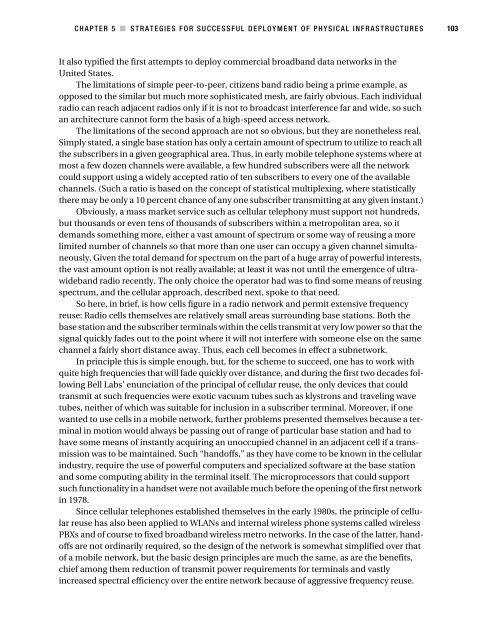WiMax Operator's Manual
WiMax Operator's Manual
WiMax Operator's Manual
Create successful ePaper yourself
Turn your PDF publications into a flip-book with our unique Google optimized e-Paper software.
CHAPTER 5 ■ STRATEGIES FOR SUCCESSFUL DEPLOYMENT OF PHYSICAL INFRASTRUCTURES 103<br />
It also typified the first attempts to deploy commercial broadband data networks in the<br />
United States.<br />
The limitations of simple peer-to-peer, citizens band radio being a prime example, as<br />
opposed to the similar but much more sophisticated mesh, are fairly obvious. Each individual<br />
radio can reach adjacent radios only if it is not to broadcast interference far and wide, so such<br />
an architecture cannot form the basis of a high-speed access network.<br />
The limitations of the second approach are not so obvious, but they are nonetheless real.<br />
Simply stated, a single base station has only a certain amount of spectrum to utilize to reach all<br />
the subscribers in a given geographical area. Thus, in early mobile telephone systems where at<br />
most a few dozen channels were available, a few hundred subscribers were all the network<br />
could support using a widely accepted ratio of ten subscribers to every one of the available<br />
channels. (Such a ratio is based on the concept of statistical multiplexing, where statistically<br />
there may be only a 10 percent chance of any one subscriber transmitting at any given instant.)<br />
Obviously, a mass market service such as cellular telephony must support not hundreds,<br />
but thousands or even tens of thousands of subscribers within a metropolitan area, so it<br />
demands something more, either a vast amount of spectrum or some way of reusing a more<br />
limited number of channels so that more than one user can occupy a given channel simultaneously.<br />
Given the total demand for spectrum on the part of a huge array of powerful interests,<br />
the vast amount option is not really available; at least it was not until the emergence of ultra-<br />
wideband radio recently. The only choice the operator had was to find some means of reusing<br />
spectrum, and the cellular approach, described next, spoke to that need.<br />
So here, in brief, is how cells figure in a radio network and permit extensive frequency<br />
reuse: Radio cells themselves are relatively small areas surrounding base stations. Both the<br />
base station and the subscriber terminals within the cells transmit at very low power so that the<br />
signal quickly fades out to the point where it will not interfere with someone else on the same<br />
channel a fairly short distance away. Thus, each cell becomes in effect a subnetwork.<br />
In principle this is simple enough, but, for the scheme to succeed, one has to work with<br />
quite high frequencies that will fade quickly over distance, and during the first two decades following<br />
Bell Labs’ enunciation of the principal of cellular reuse, the only devices that could<br />
transmit at such frequencies were exotic vacuum tubes such as klystrons and traveling wave<br />
tubes, neither of which was suitable for inclusion in a subscriber terminal. Moreover, if one<br />
wanted to use cells in a mobile network, further problems presented themselves because a terminal<br />
in motion would always be passing out of range of particular base station and had to<br />
have some means of instantly acquiring an unoccupied channel in an adjacent cell if a transmission<br />
was to be maintained. Such “handoffs,” as they have come to be known in the cellular<br />
industry, require the use of powerful computers and specialized software at the base station<br />
and some computing ability in the terminal itself. The microprocessors that could support<br />
such functionality in a handset were not available much before the opening of the first network<br />
in 1978.<br />
Since cellular telephones established themselves in the early 1980s, the principle of cellular<br />
reuse has also been applied to WLANs and internal wireless phone systems called wireless<br />
PBXs and of course to fixed broadband wireless metro networks. In the case of the latter, handoffs<br />
are not ordinarily required, so the design of the network is somewhat simplified over that<br />
of a mobile network, but the basic design principles are much the same, as are the benefits,<br />
chief among them reduction of transmit power requirements for terminals and vastly<br />
increased spectral efficiency over the entire network because of aggressive frequency reuse.
















